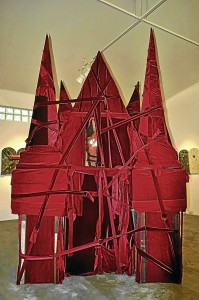
In “Desiccated Proxy” (on view at the Galleria Duemilla until Feb. 29), Jose Tence Ruiz continues to explore the paradoxes, contradictions and the absurdities of human existence, as he portrays various social ills alongside existential queries mostly with the use of Catholic symbols, in his attempt to make some sense of the complexities his finds in life.
Labeled as a Social Realist, Ruiz (who once made a name for himself as an editorial illustrator for various newspapers in the ’80s and has shifted to the finer nuances of art-making like Niel Doloricon and Danny Dalena) continues to confront, probe and question the powers that rule society such as religion, politics and economics, and the choices man makes amid the challenges that these institutions present. In this show, however, Ruiz has extended his musings toward the more sublime.
Unlike your usual down-to-earth protest Social Realism that often depicts the struggles of the working class, Ruiz’s satire has gone beyond the mere social landscape as he extends his work toward existential queries through the sublime realm of his own philosophical meanderings while tackling human deficiencies and questioning the role of God amid the suffering.
Personal iconography
“Desiccated Proxy” consists of 13 works in various media, such as painting, installation and wall-installed sculpture. It continues Ruiz’s series of personal iconography, which he has developed through the years—the “Kariton,” which symbolizes poverty and has been developed into Gothic cathedrals; the “Kotillion,” his women in grotesque attire that denotes human excesses; the crux which transforms itself to the bungee jump, referring to Christ-like pain, suffering and submission; and the recent “Dekalogo” series, taken from the idea of the 10 Commandments tablets, denoting “personal values,” “obedience” and “compliance.”
The exhibition contains all of his iconographic work. Upon entering the inner gallery of Duemilla, one is immediately struck by the prevalent essence of Catholic imagery utilized to produce works , inevitably not only hinting of the artist’s deep religious upbringing, but also the tendency to seek a higher a ground in his existential concerns.
Belief structures
This portion of the show opens questions to belief structures and the conflict between the ideals of divine perfection that religion presents against man’s foibles and the choices offered to him in this temporal existence.
This theme is highlighted by the presence of a huge and imposing mixed-media installation that dominates the inner hall—113.28 x 70.33 x 95.35-inch cathedral titled “Santuario.”
Eloquently wrapped in rich red velvet fabric and tightly bound (like a straight-jacket), the menacing Gothic architecture conjures the image of the luxurious robes of the Catholic icons tightly holding in the virtues of religious dogma.
A window reveals an interior that contains Ruiz’ kariton, filled with the sweet, almost decadent profusion of flowers, surrounded by neon-orange life-jackets bathed in a sickly red glow.
“Religion has to be some form of deep-seated neurosis, gripping us in its seductive and velvety grip, until it almost suffocates us with its densities,” the artist writes about the work.
Ruiz questions true divine intervention in the painting “Gulpe Sarado ayon sa Ngalan Niya,” oil on primed linen, as he continues to make use of the religious undertone of the exhibition with a dramatic picture of what looks like the suffering and dying Christ-like figure.
Feet bound and arms extended, ropes, forming like a cross, suspend the figure above a shadowy backdrop. Upon closer inspection, the central figure is actually a macabre composition of twisted torn limbs denoting the violence and death man inflicts upon his fellowman, as the artist cites boxers, martial artists, soldiers and zealots who invoke their God before going for the kill.
Philosophical recycling
Another religious symbol in the exhibition is the “Dekalogo” series, works shaped like the 10 Commandments tablets. Exhibiting four works of this series, Ruiz utilizes this symbol as a “metaphor for an inventory of values… How much of our personal decalogues do we abide by without compromise?”
“Dekalogo 1 Poso Pusali,” a mixed-media work created and developed from 2005-2010, shows a richly textured tablet using plumbing fixtures, one side of which is a faucet surrounded by an assortment of objects such as nails, a paintbrush, microchips, a steel bar and pipe, imbedded and “fossilized” in the hardened plaster painted to produce a weathered effect.
The other half of the tablet is a contrast of monochrome which looks like cracked marble flooring with a single toilet handle planted in it.
Utilizing the symbol for water, which in esoteric terms refers to metamorphosis and philosophical recycling, the artist brings forth an existential dilemma in this work where we find two opposing ideas—water flowing out from the faucet, and the other, flushed as waste
“…Do we turn our wells into cisterns of decay, or would we tap even the driest rock for fluid, in our search for existence?” he writes.
Ruiz has a probing and inquisitive mind. His art is dynamic in its progressively ever-changing focus—from the political terrain of his society, to pop culture, to environmental concerns, to man’s excesses and inequities.
“Desiccated Proxy, ”which seeks to touch on the mysteries of existence, takes his audience to another level of seeing.